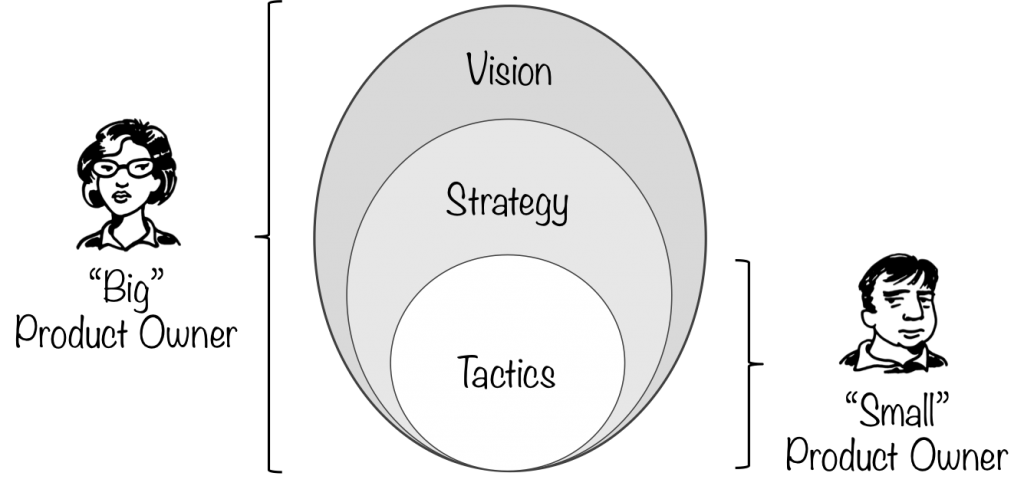
Big vs. Small
What’s a big and a small product owner? “Big” and “small” define levels of ownership. A big product owner owns the entire product; a small one takes care of the product details, as the following picture shows.

The picture above distinguishes three areas: vision, strategy, and tactics. The vision describes the ultimate reason for creating the product. The strategy covers the product strategy, the product roadmap, and the business model. The tactics refer to the product details such as epics and user stories, design sketches, scenarios, and interaction diagrams, which are typically captured in the product backlog. Distinguishing between a big and a small product owner is nothing new by the way; Rich Mirnov wrote about it in 2008 in his article “How Are We Defining Product Owners?”.
While this distinction may seem a bit theoretical, I find it rather common in practice. Many product owners I meet seem to focus first and foremost on the tactics. That’s not a problem if someone else takes care of the vision and the strategy and if the individuals work together well. But sadly, that’s not always the case.
Good vs. Bad
Being a certain height has its benefits and drawbacks just like working as a big and a small product owner. The advantage of being a big product owner is that you control all aspects of the product. As there are no hand-offs, and you should be able to make consistent decisions in a timely manner. But you may find it challenging to take on all responsibilities, as it requires a diverse set of skills and it may be too much work for a larger product.
Being a small product owner allows you to focus on the product backlog and the product details. This can help you do a great job and prevent you from getting overworked. But it requires that you effectively collaborate with the individual who owns the vision and the product strategy. Otherwise you may suffer from hand-offs, waiting and delays, loss of knowledge, inconsistent decision-making, and confusion about who decides what. Bear in mind that an effective collaboration requires that you have at least some knowledge of the strategic product aspects just like the individual looking after the vision and strategy should know what a product backlog is and how to manage it effectively.
The following table summarises the benefits and the drawback of the two product owner variants:
| Product Owner | Benefits | Drawbacks |
| Big | Consistent and fast decision-making | Diverse skills set; potentially big effort |
| Small | Focus, greater degree of specialisation | Hand-offs, delays, loss of knowledge; inconsistent decisions |
Right vs. Wrong
If both variants have the benefits and drawbacks, when is it then better to be small product owner and when to be a big one? I find a big product owner particularly beneficial when a product is young and it evolves fairly rapidly. Once it grows steadily or it has become mature, employing small product owner can be helpful to share the workload and facilitate scaling. In other words, you should make your choice based on the lifecycle stage of your product, as the following picture illustrates.

As long as your product is young and you are trying to achieve growth, it is advantageous to have person in charge of the product and to work with a big product owner. The reason for this is simple: While the strategy directs the tactics, the latter influence the former. How customers and users respond to product increments and releases can have a profound impact on the strategy. It can even cause a pivot, a significant strategy change. Take, for instance, YouTube, Flickr, and Instagram, which all changed their strategy to become successful. If several people share the product management responsibilities then the individuals will have to agree on the appropriate actions. This can slow you down significantly. In the worst case, you end up with a decision-by-committee scenario and a weak product full of compromises.
As powerful as a big product owner is, playing the role can become overwhelming once your product experiences growth, attracts more features, and becomes bigger. What’s more, as your product tends to be more stable now, and bigger changes are less likely to happen. Sharing the responsibilities across several people and employing small product owners is therefore a good option – unless you decide to unbundle your product and to promote some features to new products. Think of Facebook taking the messenger functionality of its main app and turning it into a new product , the Messenger app.
Product Manager vs. Product Owner
“The world calls them product managers,” writes Rich Mirnov about big product owners. Rich is right to point out that a big product owner largely corresponds to a traditional product manager, apart from the on-going attention to the product details and the level of collaboration with the development team. Should you hence use the term product manager instead of product owner? It’s entirely up to you. Use whichever term works best in your organisation.
But I recommend that you call the individuals who look after products either product owners or product managers to avoid confusion. A product owner is a big product owner by default in my view – just like a product manager should manage the product in its entirety. Small product owners and technical product managers are specialised roles. Use them wisely.
Learn More
You can learn more about effectively applying the product owner role by reading my book Agile Product Management with Scrum and by attending my Certified Scrum Product Owner training course.